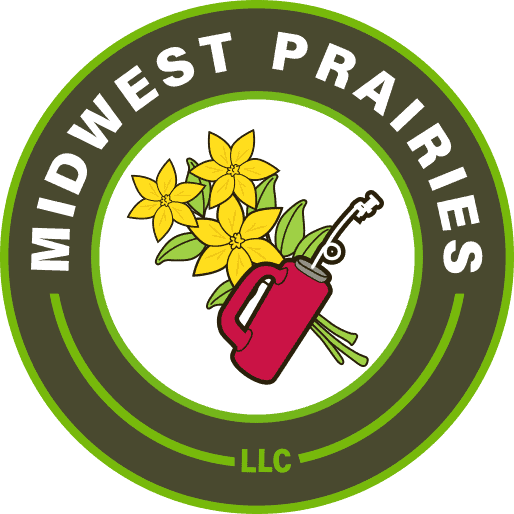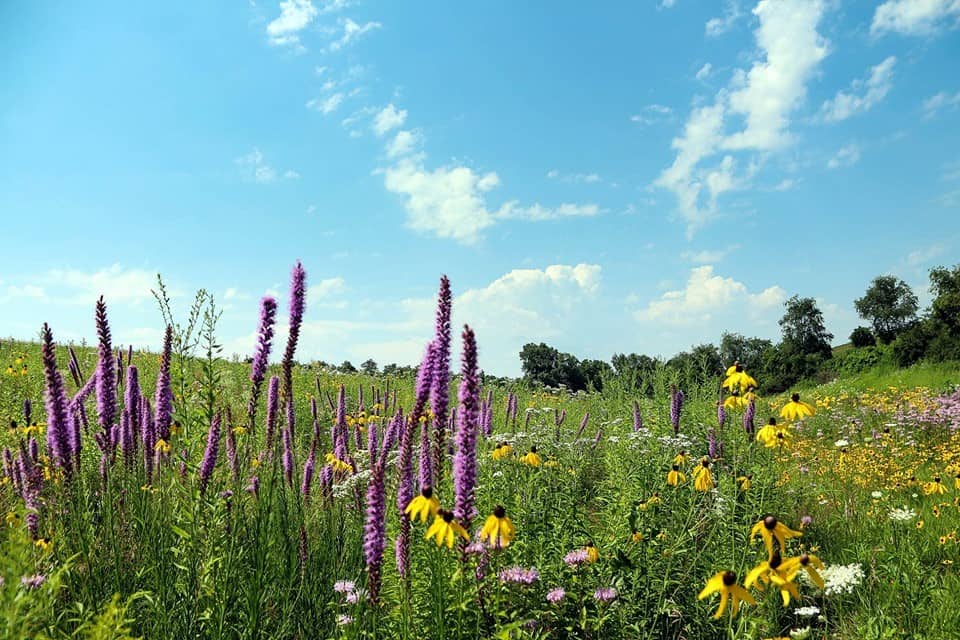A native prairie may include as many as 300 species on an acre. Botanists don’t know all the dynamics associated with this level of diversity. There may be some part of the life cycle that involves a certain insect or perhaps the need to be ingested by a certain herbivore. Given our current resources and understanding about prairie restoration, it is unrealistic to think that such diversity can be brought back without extraordinary measures.
A prairie restoration with 100 species is possible, if there is some diversity of soils and hydrology. Typically, we are shooting for 30-40 species that are commercially grown and can be expected to become established. Installing a seed mix with fewer species is certainly possible, but the habitat benefits are proportionately less.
Soil Preparation
Preparing the site for seeding is very important, especially if there is any perennial cover present. The easiest sites are former soybean fields. Generally, no preparation is required. Former cornfields must be disced thoroughly and cultipacked to make a uniform seedbed.
Areas that are former lawns or hayfields should be treated with herbicide for an entire growing season. Often, it makes sense to spray once, cultivate, then spray two or even three more times during the growing season before planting. To avoid the use of herbicide, the area must be thoroughly cultivated multiple times perhaps has many as 6 to 8 times, during the growing season.
Prairie plants are adapted to low nutrient availability. They actually do better in what we might consider “poor” soils – soils that are sandy or gravelly. Soils with high organic content, especially drained wetlands, can be a real challenge. It is never advisable to fertilize a prairie unless they are in the worst soils, such as when planting prairie to reclaim an old quarry where the soils are most excavated sand and gravel. In any other situation, fertilized will only stimulate weeds.
Planting
We usually recommend drilling seed using a no-till drill specifically designed for prairie seed. This produces the most reliable germination. However, broadcast seeding can be quite successful under the right conditions. When drilling, the seedbed must be firm. When broadcasting it can be fluffy. Ideally, after broadcasting the site should be rolled to press the seed into the surface of the soil. Seed must have direct contact with mineral soil in order to germinate, so having lots of debris or mulch on the surface is not advisable. Sometimes when we broadcast seed in a woodland environment, this is unavoidable and these plants tend to be spotty as a result. After a few years, they usually manage to spread themselves around.
Seed can be planted when soil conditions are dry enough up to late June. We have successfully planted prairies in July, but there is always a chance of a major hot and dry spell which could cause problems. While it is perfectly acceptable to plant seed prior to the month of June if soil conditions are appropriate, there is no advantage gained because prairie seed won’t germinate until the soil temperature gets relatively high in June.
Planting during the dormant season has advantages and disadvantages. In southern Wisconsin, the dormant season begins in mid October. Drilling seed occurs any time after that if soil conditions are acceptable. Some years this is a very narrow window and other years we have planted into mid December. Broadcasting can occur any time and can even be done on top of snow as long as there is not danger that the snow, and seed, will blow away.
Dormant season plantings tend to favor wildflower at the expense of grasses and vice versa in the spring. Our experience has been that this is not a noticeable difference, but that is what research has shown. One way to take advantage of this is to drill grasses and half the flower seed in the spring and broadcast the remaining flower seed in the fall.
First Growing Season
Typically, there will be a flush of weeds in the first season. The prairie plants, even under ideal conditions, will remain small and inconspicuous as they devote their resources to growing deep roots. This allows them to survive extreme weather even extended droughts. Weed competition in the first year can really hold back a prairie planting so we recommend mowing at a height of 8-12 inches once weeds get above 24 inches. This keeps the weeds from going to seed and reduces their uptake of water and nutrients thereby giving some advantage to the natives. Because the natives are small in the first season, mowing at that height does not affect them. It is important to not let the weeds get too big or the mulch created by the mowing may smother the prairie seedlings.
Second Growing Season
New prairies will remain weedy, but black-eyed Susan, bergamot, yellow coneflower, and a few others may bloom. Many of the grasses should be noticeable by August and some will go to seed. Sometimes we recommend mowing once in the early part of the second growing season, but usually, we don’t need to do any maintenance.
One major issue to look out for in the second growing season is thistles. Canada thistle is a particularly pernicious and noxious weed that must be eradicated. Bull thistle, musk thistle, and others are biennial and will eventually be outcompeted by prairie if they are controlled early on. If they are not controlled, they can overwhelm the prairie plants and ruin all the hard work and expense put forth.
There are a few herbicides that are very effective on thistles and in fact, don’t affect native grasses or many of the native wildflowers. Most sites do not have thistles problems, but when they occur it is best to address them immediately and thoroughly.
Third Growing Season
The prairie will start to look like what you had hoped for by the middle of the third season. Many of the wildflowers are present and some are blooming. Grasses should be doing quite well and will become very apparent as they go to seed in late summer. No mowing will be required although if thistles persist, they will need to be addressed.
Fourth Growing Season
It is time for the first prescribed burn. Three years of accumulated biomass should provide enough fuel to carry fire through the area planted. The prairie will still be somewhat sparse compared to what it will be in another year or two, but at least half of the wildflowers planted should be blooming.
Fifth Growing Season and Beyond
Most prairie wildflowers are very conservative. Some take many years to mature until they are ready to bloom. Even when mature, individual prairie wildflowers do not always bloom every year. It is not unusual to have a year or two with a great deal of flowers followed by a year or two without many. You may think that some species just never grew and then one day, you will find one blooming. Prairies are a dynamic ecosystem, capable of tolerating drought, flood and fire. Don’t worry about these things.
Depending on how the planting is doing by year five, it may make sense to burn a few years in a row. But, normally, a prairie can be burned every 2 to 5 years. For larger prairies it is advisable to burn on a rotation. For instance, you may divide the prairie into 2 or 3 sections and burn a different one each year. This allows insect eggs and larvae to survive in the unburned area and recolonize the burned area later in the growing season.
If you burn the prairie regularly, it should be able to hold off invasive species and outcompete them. However, it is not unusual for woody plants to make an effort to invade. Mulberry and cherry are particularly common because their seed is disseminated by birds. Regular burning will kill small seedlings but if they happen to survive long enough it may be necessary to cut and stump treat them. If a prairie is neglected long enough, it will likely revert to scrubby woods which will have lower habitat value and be expensive to rehabilitate.
Restoring the habitats and ecosystems of southern Wisconsin
We work with private land owners, park districts, state agencies, and others who wish to bring about a land restoration and enhance the environment.


